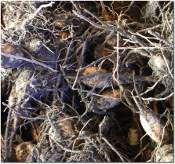If you have space, I find it best to store them as they are, with the fleshy roots partly covered in soil. However, if space is limited, the roots can be split up and stored as individual tubers.
STORING UN-SEPARATED TUBERS
 I lift my dahlias after the first frost (see 'Lifting Dahlia Tubers'), then leave them upside down to allow the moisture to drain out of the cut stems and the soil to partly dry out around the fleshy roots.
I lift my dahlias after the first frost (see 'Lifting Dahlia Tubers'), then leave them upside down to allow the moisture to drain out of the cut stems and the soil to partly dry out around the fleshy roots.As the roots dry out they become softer and more rubbery. This is good, since it allows them to tolerate light frosts.
I then invert the roots back upright and place them into storage position. But I DO NOT COVER THEM.
I find it is the neck of the tubers (the part where the swollen root joint the stem) which is most vulnerable, especially to insect larvae attack and to over-wetness. Leaving them open to dry air allows the necks and stems to dry out. "Derris" dust helps control insects.
I only cover them in mid December to protect them against the most severe of frosts, though this is probably not necessary. I am always amazed at how well they survive outside in 5 cm (20 inch) containers exposed to the full winter weather, even though the roots are very close to the surface. However, storage in smaller containers causes problems; they will not tolerate completely frozen compost.
STORING INDIVIDUAL TUBERS
 After careful removal of the soil, it is usually possible to prise a single tuber away from the rest, complete with a short piece of attached stem. These can be washed if required, and any wounds should definitely be treated with yellow sulphur powder to prevent fungal infection.
After careful removal of the soil, it is usually possible to prise a single tuber away from the rest, complete with a short piece of attached stem. These can be washed if required, and any wounds should definitely be treated with yellow sulphur powder to prevent fungal infection.Place in the refrigerator, taking care that they do not get too near to the cooler. Many growers say they store them in polythene bags, but I don't like the idea of this because they tend to sweat. And the last thing we want is a wet tuber. However, we don't want one which is too dry, either. I think I would be inclined to wrap them in kitchen towel, then place them in a polythene bag - full of holes - if they were drying out too much.
If they are dusted in sulphur, they would better tolerate slight moisture. And they might store best like this.
Examine them often for signs of disease, especially over the first few weeks. Remove problem tubers.
No comments:
Post a Comment